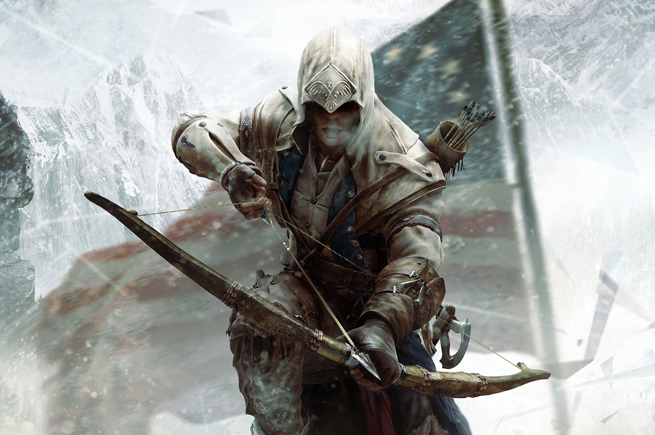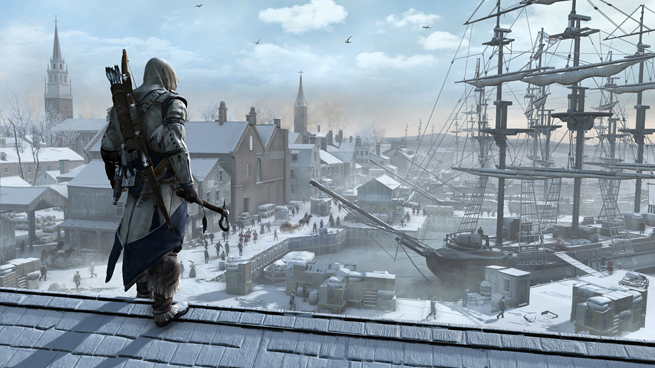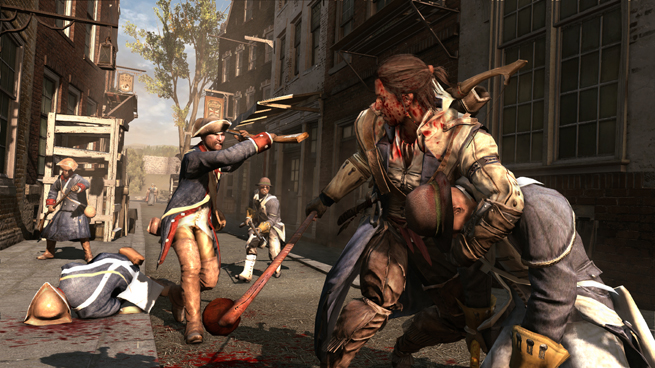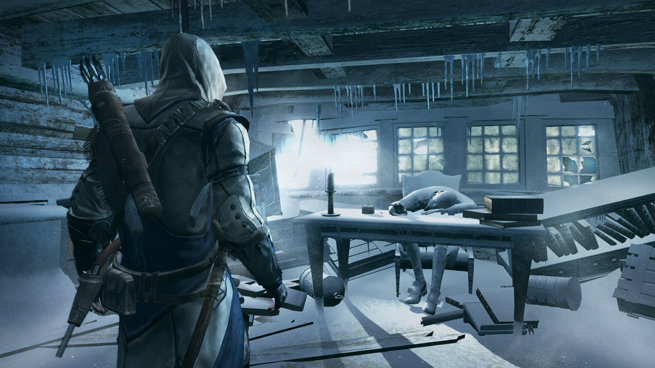The following review contains mild spoilers only.
It’s the end of the world as we know it, and I feel like jumping through trees and stabbing random Englishmen. Hey, it’s not like you’d have a better idea.
Fortunately, Assassin’s Creed III (releasing today on PlayStation 3 and Xbox 360, Nov. 18 on Wii U, and Nov. 20 on PC) steps up as my morally flexible enabler. This time, the action moves up from Renaissance Italy to Revolutionary America as the Order of the Assassins and the Knights Templar bring their centuries-old conflict to the New World at the onset of the War for Independence. Their clashes in the 1700s revolve around the same “First Civilization” vault that 21st century assassin Desmond Miles hopes can somehow head off the impending apocalypse … scheduled for Dec. 21, 2012.
The key to activating those ancient technologies lies in the past. With the doomsday clock ticking down, Desmond once again enters the Animus to relive his ancestors’ adventures in professional murder and uncover the secrets they buried.
And so developer Ubisoft Montreal finally closes the book on the historical epic they started five years ago. The ride hasn’t always been smooth. As a franchise, Assassin’s Creed pulled off several incredible highs and sunk to a few disappointing lows (tower-defense minigames, anyone?). Perhaps then it’s fitting that Assassin’s Creed III, as the culminating chapter, does both.
WHAT YOU’LL LIKE
Viva la revolution
The plot moving Assassin’s Creed forward might involve Nostradamus’s predicted end-of-days, but its appeal lies in touring history as a highly trained killer. We’ve been a monk and a swashbuckler, and now we get two new archetypes to play around with — the English gentleman and the angry young rebel.
You might even wonder if you threw in the right game at first. The opening fifth of Assassin’s Creed III casts you not as cover-boy Connor but as Haytham Kenway, a cultured noble with hidden blades and unshakeable convictions. He’s like a 1950s action hero (I kept picturing Stewart Granger in King Solomon’s Mines), approaching problems with charm and pleasant optimism right before offering decapitation as a solution to people who offend his honor. I actually like Haytham as a character more than Connor, the impatient Anglo-Mohawk son he’s forced to abandon, though Connor’s arc resonates better.
Through Connor, we see the difficult birth of the American experiment … its flaws, its compromises, and its outright lies. We throw crates of tea into Boston Harbor. We ride with Paul Revere (amusingly portrayed like an extremely naggy Patton Oswalt). We fight at Bunker Hill, Lexington and Concord, and the Battle of the Chesapeake. We watch as the Founding Fathers sign the Declaration of Independence, and we get frequent reminders how, unlike Connor, they were realists, not idealists. It wasn’t lost on me that a chat with Samuel Adams about marketing the war as a struggle for freedom happened just a few feet away from a slave sweeping the floors of Independence Hall. The hypocrisies aren’t lost on Connor, either.
As with Italy and the Middle East before it, Ubisoft Montreal does an outstanding job in world building here. Rich details sell 18th century Boston and New York in all their rough glory, while the quiet stillness of the wilds feel particularly affecting in winter. The sound design doesn’t always keep up, though, and the audio even cuts out on occasion.
As big-picture as all this sounds, Haytham’s and Connor’s personal trajectories consistently entertain. The final confrontation between Connor and his nemesis in particular plays out beautifully (though a lack of interaction seems an odd choice, all things given). Getting there takes you through places and ideas that defined us as a nation, for better and worse, and these can be very powerful moments.
Variety is the spice of death
Stellar mission design and flow has been a major strength of the series since Assassin’s Creed II, and for the most part, the new installment follows suit. Sure, you spend the majority of your time sprinting, stalking, and stabbing, but the focus constantly shifts in interesting ways. As an example, one sequence has you ambush a convoy, sneak it past several checkpoints, quietly free a number of captives right under their captors’ noses, and then fight your way through a pitched battle to reach your target, all in rapid succession. The game maintains that level of variety throughout the campaign.
If that didn’t do the job, we also get a few one-off tasks that break away from the standard gameplay. Generals grudgingly give Connor command of patriot firing lines or have him man an 18-pounder cannon to hold off the British advance. Both qualify as tower-defense lite, but enjoyably so. Pulling them out more often would’ve become tedious, but limited to where they are, these both work nicely.
And I count the all-new naval missions aboard the Aquila, Connor’s heavily armed schooner, as a definite highlight. The bells, snapping sails, and creaking wood fire up all my pirate instincts, and I start hunting for a British armada to punch through. The Aquila comes with a serious learning curve — you simultaneously pilot the ship, call for more or less speed, dodge incoming fire, select which cannonballs to use, and order the gun crews to fire. You can also light up enemy vessels by tagging their exposed powder magazines with a single well-placed shot. That’s a lot to keep track of all at once, but it didn’t take long before I adeptly traded broadsides with frigates in the Chesapeake, laughing madly in the heart of a storm.
No lie, it’s annoying how a rogue wind always seems to hit the old girl the moment you put on full sail, but few things satisfy quite like landing a solid port-side salvo and then tacking to finish off your victim with the starboard guns. I could easily play the navel missions as their own standalone game. They offer action, strategy, and really big boats with lots and lots of upgradable firepower. Sold.
So much to see, so much to do
Unless you’re a superhumanly gifted speed runner, it takes at least 20 hours to plow through the campaign. Tack on a minimum 10 more to claw your way through all the side quests and activities available to you.
The Aquila offers a host of opportunities — escorts, races, pure seek-and-destroy engagements on the high seas — but you won’t run out of things to do on dry land. Assassin’s Creed III draws heavily from Assassin’s Creed: Brotherhood in that regard. Count that as a plus. You can recruit more assassins into your order and train them up for use against any redcoats in your way (you don’t even need to visit pigeon coops to send them on assignment anymore). Taking on liberation missions frees districts from English control. So does taking out a fort. You left Ezio’s castle back in the 16th century, but feel free to trick out Connor’s homestead and invite artisans, farmers, and hunters to work there. That also lets you play business mogul, selling goods made on your property for a tidy profit.
More content unlocks contextually. If you hunt forest creatures on a regular basis, a member of the Hunting Society will invite you into their club. You can’t buy a bunch of instant henchman anymore, but you can periodically start riots for free. Raid a redcoat convoy. Plant evidence on a loyalist snitch. Beat up price-gouging merchants. Burn plague-ridden blankets. Deliver letters. Play checkers. And that’s before you dig into all the side missions handed out by smelly frontiersmen, replacing the gently swaying prostitutes from previous games. Decide for yourself whether or not that’s an improvement.
It’s almost daunting how much you can do. Luckily, nothing’s mandatory. I completed the game without buying, selling, or upgrading anything, and I only performed a fraction of the optional content. Odds are I’ll go back and dig further into Assassin’s Creed III to see what I missed.
But first, I’ll have to get over some of its more glaring issues.




